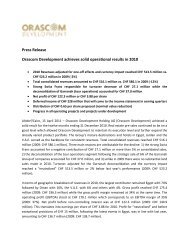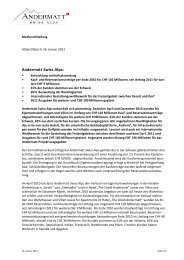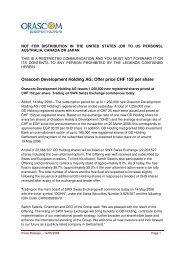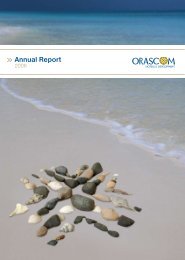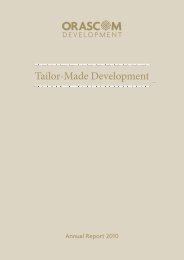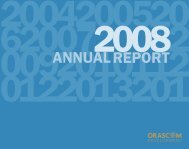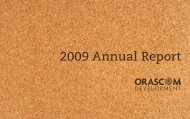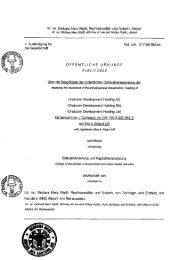FY 2012 Annual Report - Orascom Development
FY 2012 Annual Report - Orascom Development
FY 2012 Annual Report - Orascom Development
You also want an ePaper? Increase the reach of your titles
YUMPU automatically turns print PDFs into web optimized ePapers that Google loves.
F-31 <strong>Orascom</strong> <strong>Development</strong> <strong>2012</strong> <strong>Annual</strong> <strong>Report</strong> F-32<br />
4.2.4 Impairment of goodwill<br />
Determining whether goodwill is impaired requires an estimation of the value in use of the cash-generating units to which<br />
goodwill has been allocated. The value in use calculation requires management to estimate the future cash flows expected to arise<br />
from the cash-generating unit and a suitable discount rate in order to calculate present value.<br />
The carrying amount of goodwill at the end of the current reporting period is CHF 7,331,756 (31 December 2011: 7,951,210). The<br />
recoverability of goodwill is tested for impairment annually during the fourth quarter, or earlier, if an indication of impairment<br />
exists. The value of goodwill is primarily dependent upon projected cash flows, discount rates (WACC) and long-term growth<br />
rates. The significant assumptions are disclosed in note 18. As at 31 December <strong>2012</strong> the annual impairment test showed no<br />
impairment loss (2011: none). Changes to the assumptions may result in further impairment losses in subsequent periods.<br />
4.2.5 Provisions<br />
The carrying amount of provisions at the end of the current reporting period is CHF 79,106,988 (31 December 2011: CHF<br />
90,144,020). This amount is based on estimates of future costs for infrastructure completion, legal cases, government fees,<br />
employee benefits and other charges including taxes in connection with the Group’s operations (see note 32). As the provisions<br />
cannot be determined exactly, the amount could change based on future developments. Changes in the amount of provisions due<br />
to change in management estimates are accounted for on a prospective basis and recognized in the period in which the change in<br />
estimates arises.<br />
4.2.6 Impairment of trade and other receivables as well as other current assets<br />
An allowance for doubtful receivables is recognized in order to record foreseeable losses arising from events such as a customer’s<br />
insolvency. The carrying amount of the allowance for trade and other receivables at the end of the current reporting period is<br />
CHF 42,730,631 (31 December 2011: CHF 23,127,659) (see note 25). In determining the amount of the allowance, several factors are<br />
considered. These include the aging of accounts receivables balances, the current solvency of the customer and the historical<br />
write-off experience.<br />
A similar assessment has been done in relation to the recoverability of other current assets amounted to CHF 74,015,193 (2011:<br />
CHF 73,719,589) which includes amounts due from employees and management (see note 23), outstanding proceeds from the sale<br />
of the six percent stake in the former Garranah subsidiaries and the entire interests in the Joud Funds 1, 2, 3 and 4 (see note 23). To<br />
determine the need for the recognition of any impairment charge, management considered several factors, such as the<br />
contractual repayment date, current solvency of the counterparty and historical write-off experience. In <strong>2012</strong> an impairment<br />
charge of total CHF 9.9 million has been booked in relation to the amounts outstanding from employees and management. CHF<br />
8.8 million were netted off whereas CHF 1.1 million are included in provisions<br />
At 31 December 2011, an impairment charge of CHF 18 million was recorded in addition to the CHF 15 million charged in 2010 to<br />
cover any shortfall that might occur in relation to Joud Fund 1, 2, 3 and 4.<br />
The actual write-offs and / or impairment charges might be higher than expected if the actual financial situation of the customers<br />
and other counterparties is worse than originally expected.<br />
4.2.7 Deferred income taxes<br />
The measurement of deferred income tax assets and liabilities is based on the judgment of management. Deferred income tax<br />
assets are only capitalized if it is probable that they can be used. Whether or not they can be used depends on whether the<br />
deductable tax temporary difference can be offset against future taxable gains. In order to assess the probability of their future<br />
use, estimates must be made of various factors including future taxable profits. At 31 December <strong>2012</strong> deferred income tax assets<br />
amounted to CHF 30,999,043 (31 December 2011: CHF 30,681,825) that have mainly resulted from the tax impact of carry forward<br />
tax losses (see note 13.4). Such deferred tax assets are only recorded when the development phase of the project has been started<br />
and it becomes evident that future taxable profits are probable. If the actual values differ from the estimates, this can lead to a<br />
change in the assessment of recoverability of the deferred tax assets and accounting for such a change, if any, is to be made on a<br />
prospective basis in the reporting periods affected by the change.<br />
4.2.8 Retirement benefit obligations<br />
The retirement benefit obligation is calculated on the basis of various financial and actuarial assumptions. The key assumptions for<br />
assessing these obligations are the discount rate, future salary and pension increases and the probability of the employee reaching<br />
retirement. The obligation was calculated using a discount rate of 2.00% (31 December 2011: 2.40%). Pension costs were<br />
calculated on the basis of an expected return on investment on plan assets of 3.00% (31 December 2011: 3.00%). The calculations<br />
were done by an external expert and the principal assumptions used are summarised in note 38. At 31 December <strong>2012</strong>, the<br />
underfunding amounted to CHF 2,935,142 (31 December 2011: CHF 2,352,983), whereby only CHF 871,355 (31 December 2011: CHF<br />
416,295) were recorded as an obligation in the consolidated statement of financial position because the corridor approach is used.<br />
Using other basis for the calculations could have led to different results.<br />
4.2.9 Classification and valuation of investment property<br />
Generally real estate units are constructed either for the Group’s own use or for the sale to third parties and carried at cost.<br />
However, when a unit may not be sold, as soon as a long term rent contract over more than 1 year is agreed with a third party at<br />
market conditions, the unit is classified as an investment property and measured at the fair value obtained from independent,<br />
third party valuation experts. The fair value of investment properties at 31 December <strong>2012</strong> is CHF 78,903,321 (2011: CHF<br />
76,366,131).<br />
The fair value of each of these properties has been arrived at on the basis of valuations carried out, at the dates specified above, by<br />
Messrs Alan Tinkler, Ramlackhan & Co and Fincorp, independent valuation specialists not related to the Group. Note 17 provides<br />
detailed information about the valuation techniques applied and the key assumptions used in the determination of the fair value<br />
of each investment property.<br />
4.2.10 Net realisable value of inventory<br />
Inventory mainly includes real estate construction work under progress which is recognised at cost or net realisable value. The<br />
majority of real estate under construction (approximately three quarters) is already sold at market prices which are significantly<br />
higher than construction cost. Therefore the estimation uncertainty only relates to the unsold real estate under construction. In<br />
general the profit margins on these real estate projects are high and management currently does not expect any of these projects<br />
to be sold below cost.<br />
4.2.11 Infrastructure cost<br />
The Group has an obligation under the terms of its sale and purchase agreements to develop the infrastructure of the sold land.<br />
Infrastructure cost is deemed to form part of the cost of revenue and is based on management estimate of the future budgeted<br />
costs to be incurred in relation to the project including, but are not limited to, future subcontractor costs, estimated labor costs,<br />
and planned other material costs. The provision for infrastructure costs requires the Group’s management to revise its estimate of<br />
such costs on a regular basis in light of current market prices for inclusion as part of the cost of revenue.<br />
4.2.12 Liquidity shortages and related uncertainties<br />
For further details on management’s plans to manage liquidity shortages and related uncertainty please refer to note 43.1.<br />
5 THE GROUP AND MAJOR CHANGES IN GROUP ENTITIES<br />
The Group is comprised of the Parent Company and its subsidiaries operating in different countries.<br />
There have been no major changes in the group structure during the period except for the sale of the last remaining subsidiary<br />
operating in the tour operations segment (note 36), the disposal of Lupp Middle East, an Omani subsidiary of the Group (note 36),<br />
as well as the deemed loss of control of the Swiss subsidiary Andermatt Sedrun Sportbahnen AG due to the acquisition of two<br />
companies operating skiing areas (note 37).<br />
<strong>Orascom</strong> Hotels & <strong>Development</strong> SAE (“OHD”) remains the principal operating subsidiary and is located in Egypt.<br />
The group controls its subsidiaries directly and indirectly.<br />
6 REVENUE<br />
An analysis of the Group’s revenue for the year is as follows:<br />
CHF <strong>2012</strong> 2011<br />
Revenue from the rendering of services and rental income 195,491,243 184,537,743<br />
Revenue from agreements for construction of Real Estate and construction<br />
revenue<br />
76,409,607 66,969,813<br />
Revenue on sale of land - 2,254,067<br />
TOTAL 271,900,850 253,761,623<br />
F-31<br />
F-32



